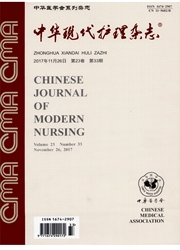

 中文摘要:
中文摘要:
目的 探讨智能型碳纤维婴儿保暖包被在极低出生体重儿出生后转运环节中的应用效果及对入室体温和预后产生的影响.方法 将125例极低出生体重儿按照随机原则分为研究组62例和对照组63例,对照组采取传统的保暖措施,即新生儿出生后立即置于辐射保温台上,用预热的毛巾擦干身体,移去湿巾,戴帽,护理完毕后用传统婴儿包被包裹送往NICU,研究组在常规保暖的基础上使用智能型碳纤维婴儿保暖包被,比较两组极低出生体重儿入室时的直肠温度和住院期间并发症及转归情况.结果 研究组入室体温低于35℃和35 ~ 36℃者分别为0,19例均低于对照组(11,31例),两组比较差异有统计学意义(P<0.01);研究组入室中位体温36.3℃,明显高于对照组35.5℃,两组比较差异有统计学意义(Z=31.13,P<0.05);研究组极低出生体重儿入室时的pH值和BE值比对照组高,差异有统计学意义(x2值分别为4.18,5.01;P<0.05);研究组低血糖发生率1.6% (1/62)、颅内出血发生率14.5%(9/62),对照组分别为12.7%(8/63),30.2% (19/63),两组比较差异有统计学意义(x2值分别为5.57,4.40;P<0.05);研究组住院天数中位数39 d,对照组为46 d,两组比较差异有统计学意义(Z=4.428,P<0.05);两组病死率比较差异无统计学意义(x2=0.573,P>0.05).在研究过程中研究组未发生体温过高(体温>37.5℃)及皮疹等不良反应.结论 使用智能型婴儿保暖被可降低极低出生体重儿入室低体温的发生率,降低其并发症的发生,缩短住院日,适合极低出生体重儿的转运.
 英文摘要:
英文摘要:
Objective To explore the application effect of "intelligent carbon fiber baby quilt" on the admission body temperature and complication in infants with verylowbirth weight after birthduring the transport.Methods One hundred twenty-five infants with verylowbirth weight from May 2011 to April 2012 were randomly divided into the experimental group (n =62) and the control group (n =63).The control group received the traditional warm measures including immediately laying the newborn infants in radiant heat table after birth,toweling off with the preheating towel,removing the wet towel,putting on hat,sending the infants wrapped with traditional packet to the NICU after nursing,and the experimental group received the "intelligent carbon fiber baby quilt" on the basis of traditional warm measures.The rectal temperature,the occurrence of complications and prognosis during hospitalization were compared in two groups.Results The cases of admission hypothermia including less than 35 ℃ and 36 ℃ were respectively 0,19,in the experimental group,and were lower than 11,31 in the control group,and the difference was statistically significant (P 〈 0.01).The median of admission body temperature was 36.3 ℃ in the experimental group,and were significantly higher than 35.5℃ in the control group,and the difference was statistically significant (Z =31.13,P 〈 0.05).The pH value and BE value in the experimental group were higher than those in the control group at the admission,and the differences were statistically significant (x2 =4.18,5.01,respectively; P 〈 0.05).The incidence of hypoglycemia and intracranial hemorrhage were respectively 1.6% (1/62),14.5% (9/62) in the experimental group,and were 12.7% (8/63),30.2% (19/63) in the control group,and the differences were statistically significant (x2 =5.57,4.40,respectively;P 〈 0.05).The median of the days of hospitalization was 39 d in the experimental group,and was 46 d in the control group,and the differe
 同期刊论文项目
同期刊论文项目
 同项目期刊论文
同项目期刊论文
 期刊信息
期刊信息
